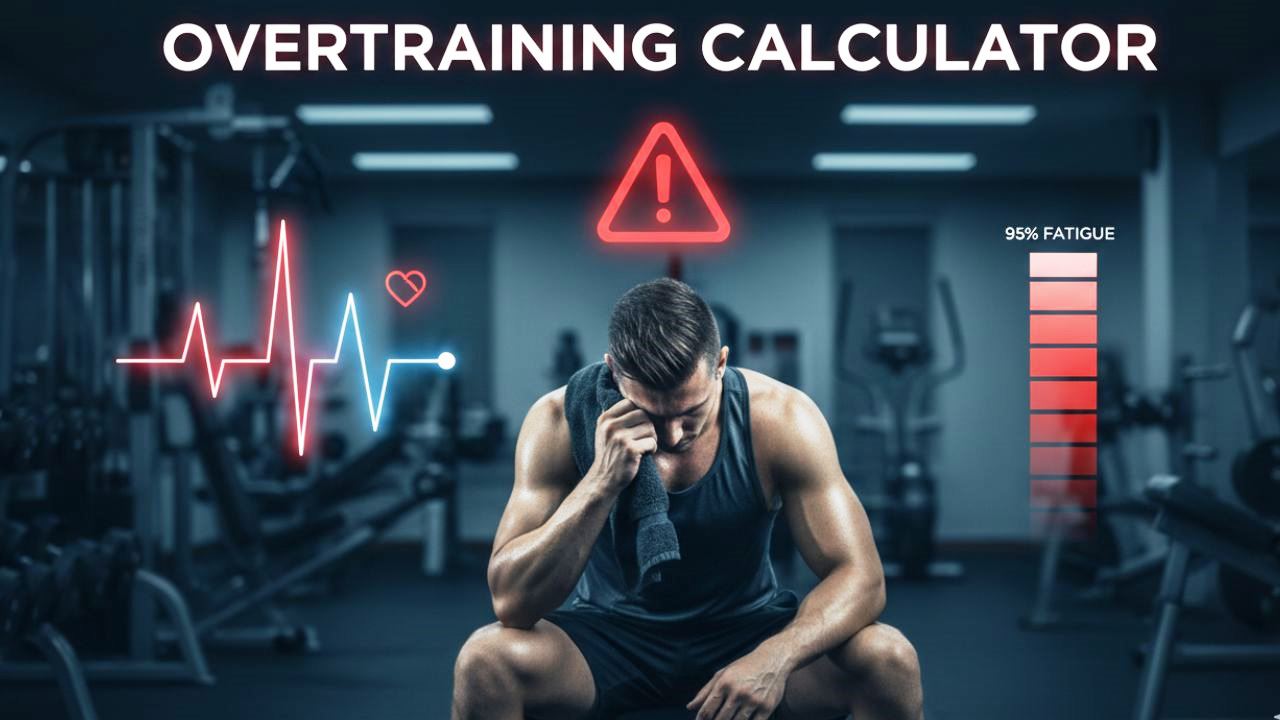⚠️ Overtraining Risk Calculator
Science-based assessment tool to identify warning signs and prevent training burnout

What is Overtraining Syndrome?
Overtraining Syndrome (OTS) happens when you train harder than your body can recover from. Unlike regular workout fatigue that disappears with rest, overtraining causes lasting performance drops, mood problems, and exhaustion that can last weeks or even months.
Example: Training 6 days/week + High intensity + Poor sleep (5 hours) + High life stress = 75% risk
2023 research shows overtraining affects your brain too—not just muscles. Athletes show slower reactions and worse decision-making during workouts.
Key Difference: Normal fatigue = better after 1-2 rest days. Overtraining = needs weeks or months to recover.
Three Stages: From Tired to Overtrained
Feeling: “I’m tired but a rest week will fix it”
Stage 2 – Non-Functional Overreaching: Recovery in 2 weeks to 2 months
Feeling: “Even after rest, I’m still exhausted”
Stage 3 – Overtraining Syndrome: Recovery in 2-12+ months
Feeling: “Nothing helps, I can’t train anymore”
Simple Test: Take 1 week completely off. If you still feel exhausted and performance hasn’t improved, you’re past Stage 1.
Stage 1 is actually useful—many training programs intentionally push you here then back off. Stages 2 and 3 are what we want to prevent.
Warning Signs You’re Overtraining
Watch for these red flags that indicate you need more recovery:
Normal baseline: 60 bpm
Today’s reading: 70 bpm (+10 bpm)
= Warning: You need extra recovery today
- Physical Red Flags: Muscles always sore, getting sick often, resting heart rate up 5-10 bpm, unexplained weight loss
- Performance Red Flags: Weights feel heavier than usual, can’t finish normal workouts, taking longer to recover between sessions
- Mental Red Flags: Don’t want to train (not just lazy—genuine loss of desire), feeling irritable or down, trouble sleeping despite being exhausted
Research shows your heart rate variability (HRV) drops before performance does—making it an early warning system. Many fitness watches now track this automatically.
How to Prevent Overtraining
Smart Training Without Burnout
Week 2: Run 22 miles (20 + 10% = 22 miles max)
Week 3: Run 24 miles
Week 4: DELOAD to 12 miles (50% reduction)
Week 5: Back to 24 miles, recovered and ready
- Never jump more than 10%: If you ran 20 miles last week, don’t run more than 22 this week
- Take deload weeks: Every 3-4 weeks, cut your training in half for one week
- Mix easy and hard: Don’t train hard every day—include light recovery sessions
- Track your workload: Write down total sets, reps, or miles each week
Sleep: Your Secret Recovery Weapon
Athlete (moderate training): 8-9 hours
Athlete (intense training): 9-10 hours
If showing fatigue signs: Add 1 extra hour until recovered
Studies prove poor sleep = higher overtraining risk. It’s not optional—it’s where your body repairs itself.
- Same schedule daily: Bed at 10 PM, wake at 6 AM—even weekends (your body loves routine)
- Keep it cool and dark: 60-67°F room temperature, blackout curtains or eye mask
- No screens before bed: Put your phone away 1 hour before sleep
- Eat protein after training: Within 2 hours post-workout helps muscles recover overnight
- Light activity on rest days: Walking or gentle stretching keeps blood flowing for recovery
5-Minute Daily Check (Catch Problems Early)
Rate your sleep (1-10): 8 = good
Rate muscle soreness (1-10): 4 = normal
Rate motivation (1-10): 7 = good
Rate stress (1-10): 5 = manageable
If 2+ categories are worse than normal = take an easy day
- Heart rate check: Before getting up, count your pulse for 60 seconds. If it’s 5-10 beats higher than your normal = red flag
- Rate 5 things (1-10): Sleep quality, soreness, stress, mood, motivation. Track in your phone notes
- How workouts feel: Don’t just track sets/reps. Note: “Felt strong” or “Struggled today”
- Do you WANT to train?: Consistent “meh” feeling = early warning (different from occasional laziness)
⚕️ Medical Disclaimer
This Overtraining Risk Calculator provides educational information based on scientific research and should not replace professional medical advice. Overtraining syndrome requires proper medical diagnosis and treatment. Individual symptoms vary significantly, and other medical conditions can mimic overtraining symptoms. If you experience persistent fatigue, performance decline, mood changes, or other concerning symptoms, consult with a sports medicine physician, certified athletic trainer, or healthcare provider for proper evaluation. The assessment provided is for educational purposes and general guidance only. Do not delay seeking medical attention if symptoms are severe or worsening.
References
- Armstrong, L. E., Bergeron, M. F., Lee, E. C., Mershon, J. E., & Armstrong, E. M. (2022). Overtraining Syndrome as a Complex Systems Phenomenon. Frontiers in Network Physiology, 1, 794392. https://doi.org/10.3389/fnetp.2021.794392Kreher, J. B., & Schwartz, J. B. (2012). Overtraining Syndrome: A Practical Guide. Sports Health, 4(2), 128. https://doi.org/10.1177/1941738111434406
- Fiala, O., Hanzlova, M., Borska, L., Fiala, Z., & Holmannova, D. (2025). Beyond physical exhaustion: Understanding overtraining syndrome through the lens of molecular mechanisms and clinical manifestation. Sports Medicine and Health Science, 7(4), 237-248.
- Symons, I. K., Bruce, L., & Main, L. C. (2023). Impact of Overtraining on Cognitive Function in Endurance Athletes: A Systematic Review. Sports Medicine – Open, 9(1), 1-11. https://doi.org/10.1186/s40798-023-00614-3
